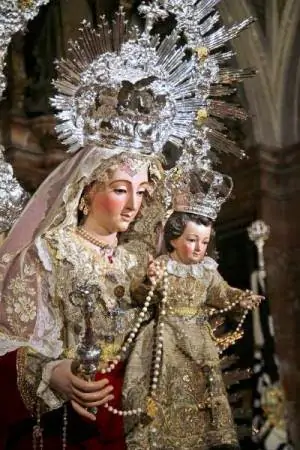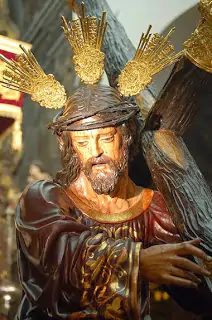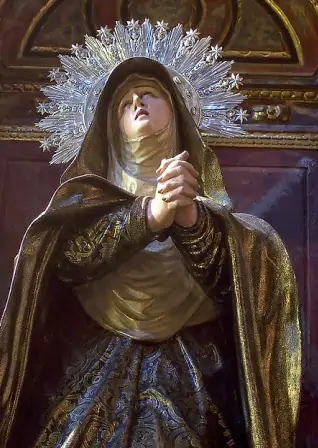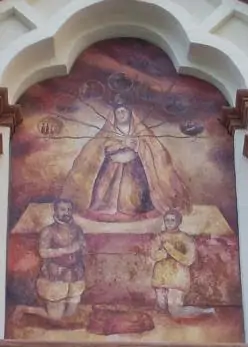Headquarters of Former Brotherhoods and Guilds
History
Illustrious and Primitive Brotherhood of Our Lady of the Rosary
Its history as an autonomous brotherhood is one of the most significant in the city from its creation until the 19th century.
The first Rosary Brotherhoods emerged within the Dominican Order from 1479, and according to Romero Mensaque, everything seems to indicate that one of these Brotherhoods was founded in the Royal Convent of San Pablo at a very early date, 1481, with Fray Alonso de Ojeda as prior, although the oldest documentation preserved dates from the late 16th century.
The Rosary Brotherhood originally occupied one of the Chapels of the Conventual Church, but soon the members obtained authorization from Archbishop Fray Diego de Deza (1505-1523), also a Dominican, to build a chapel adjacent to the temple—the current sacramental chapel—as it had significant financial resources, including members from the city's nobility.
In the second half of the 17th century, there was a greater openness to other social classes due to the spread of the Rosary after the plague of 1649 and its rise as a central devotion in all popular missions. The Convent of San Pablo was one of the most important focal points where Rosary processions with their banners gathered. Among the 582 brothers registered in the 17th-century brotherhood book, Bartolomé Esteban Murillo stands out, who was a brother of the brotherhood until his death.
The current and beautiful Image of Our Lady of the Rosary, carved in 1787, is the work of Cristóbal Ramos.
In the 19th century, the Illustrious and Primitive Brotherhood of Our Lady of the Rosary experienced a profound decline following the confiscation of the assets of the Convent of San Pablo, whose community was exclaustrated. To ensure its survival, it merged in 1867 with the penitential brotherhood of the Holy Christ of the Conversion of the Good Thief and Our Lady of Montserrat. This merger lasted until 1941 when, due to a disagreement between the Brotherhood and the Parish, a Decree of separation was issued. From that moment on, the life of the Rosary Corporation languished completely.
In the 1980s, the custody of the image of Our Lady of the Rosary was entrusted to the Sacramental Brotherhood, which paid tribute to her during her feast. The only surviving brother in its registry, Don Rafael Jiménez Cubero, initiated the procedures for its revitalization, and on January 10, 2006, the new Rules of this Illustrious and Primitive Brotherhood of Our Lady of the Rosary were approved. Subsequently, the Brotherhood merged again with the penitential Brotherhood of the Holy Christ of the Conversion of the Good Thief and Our Lady of Montserrat, who currently has the Virgin of the Rosary as one of its titular figures, paying homage to her in the parish church around October 7.
Brotherhood of Our Father Jesus Nazarene and Our Lady of the Ancient, Seven Sorrows, and Compassion
The Brotherhood of Our Father Jesus Nazarene and Our Lady of the Ancient, Seven Sorrows, and Compassion evokes the glorious past of our brotherhoods. Its memory reaches our days, leaving as a legacy its titular images: Our Father Jesus Nazarene, currently in the parish of San Nicolás where he is the titular of the Brotherhood of La Candelaria with the invocation of Our Father Jesus de la Salud, and Our Lady of the Ancient and Seven Sorrows, who receives worship in the parish of Santa María Magdalena in a chapel of the transept.
The Brotherhood of Our Lady of the Ancient was founded in 1546, a product of the existing fervor for this Marian devotion, which presides over the most important cathedral chapel after the Royal Chapel. Fifty years later, the penitential Brotherhood of the Sorrows of the Blessed Virgin, founded in the convent of Santo Domingo de Silos, merged with that of the Ancient.
Its devotion was symbolized by the enormous silver heart worn on the chest, pierced by seven knives representing the Seven Sorrows of the Virgin. Its immense popularity among the people of Seville led it to preside over supplications for droughts in 1680 and 1736, as well as supplications for the War of Succession in 1706.
The brotherhood had enormous significance due to the membership of prominent and illustrious members of Sevillian and Spanish society, including monarchs Philip II and Philip III. It made a penitential procession to the cathedral on Holy Thursday, making stops at the Monument and the cathedral chapel of Our Lady of the Ancient.
In 1766, it made its last penitential procession, undergoing a long decline that worsened in the early 19th century with the sale of its floats and belongings. As a curiosity, in addition to the titular images, the brotherhood's chapel has survived to this day, now owned by the Brotherhood of Montserrat, as well as the exterior embroidery of the canopies of its canopy, which currently adorns the Virgin del Valle.
Its titular images are of immense value: Our Father Jesus Nazarene (now Lord of Health) is attributed to the carving of Francisco de Ocampo. The Virgin of the Ancient and Seven Sorrows has been attributed to Pedro Roldán, created in the mid-17th century, but new theories suggest its creation until the beginning of the same century, considering it more a work of Andrés de Ocampo.
The historical and artistic value of the image from the early 17th century known as Our Lady of the Ancient and Seven Sorrows is immense. Above all, its devotional value, as «there are few images in this city, with so many of the Blessed Virgin, that have had the devotion that this one has had, and few also that equal it in fame and name,» in the words of José Bermejo y Carballo in his work "Religious Glories of Seville," published in 1882."




